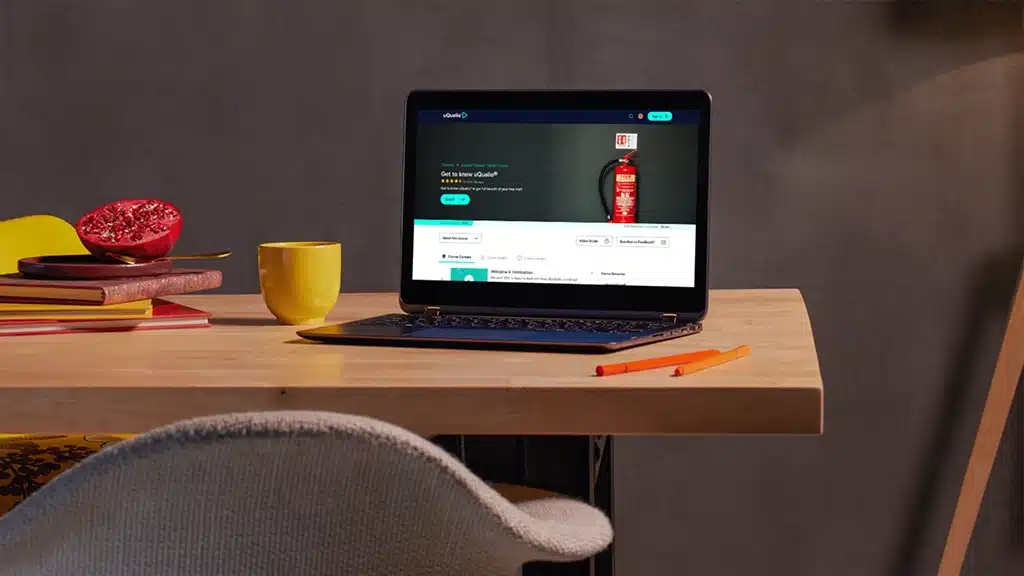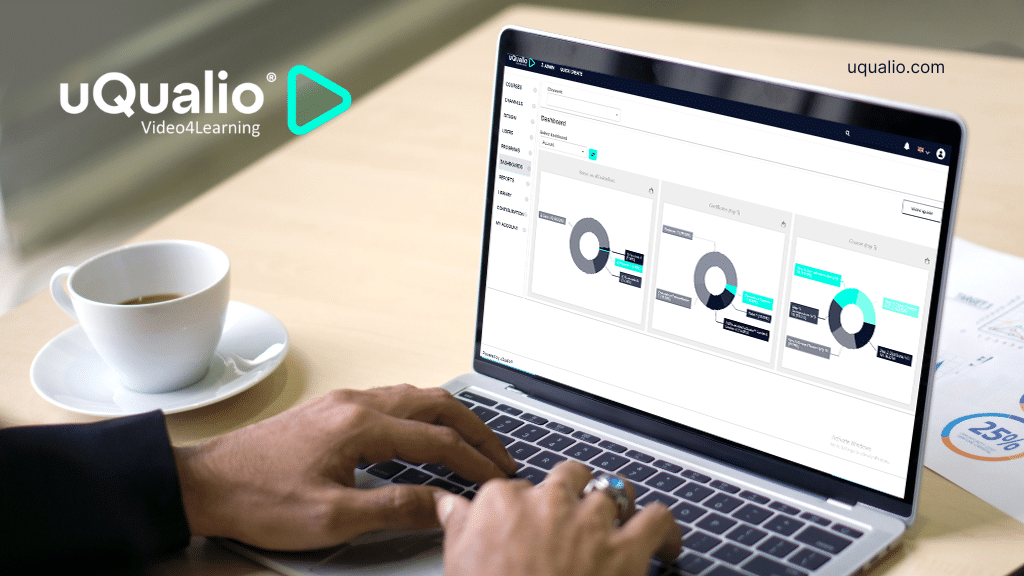CONSIDER THEMSELVES AS DESIGNERS OF LEARNING LANDSCAPES

Design thinking is a toolkit used by professionals around the world to produce innovative solutions to complex problems and improve real-world experiences. Since it’s a toolkit used in successful real-world learning environments, outside of the education world, you need to provide students with real-world context when teaching students how to use the methodology
uQualio®, the makers of your favorite video eLearning creation authoring software recently had the opportunity to sit down and chat with David Lee , an EdTech expert and author of the book Design Thinking in the Classroom .
In the interview below we chat with David about many topics relating to effectively teaching courses online. We explore the importance of design thinking, creating project-based e-courses, transdisciplinary pedagogy, and eduPermaculture.
Let’s jump in!
Hi David and thank you for taking the time to chat with our blog readers today about your experience in the EdTech space. You are a STEM and design coach at Singapore American School, a keynote speaker on topics related to EdTech, as well as a Google and Apple Distinguished Educator. These are just some of the titles that you hold related to education. So why don’t you get this interview started by telling our audience how you got started in the EdTech space?
I guess I started my EdTech journey right after getting my teaching credential at a California State University. My professors for my credential program were also professors for the university’s EdTech master’s program. At the time, it was difficult to get hired as a teacher due to the recession, so I decided to move to South Korea to teach English at an academy, but at the same time enroll in the EdTech master’s program which was fully online. My master’s degree was what helped me to eventually get an internship as a technology teacher for preschool students, up to 2nd-grade students at Korea International School. I was immediately drawn to the way students gained confidence in themselves when they learned technical skills that they thought were too difficult to gain. This sense of empowerment for the students was what got me hooked with teaching as well as teaching students valuable technology skills. I eventually started to collaborate with homeroom teachers to develop tech-integrated projects for their units. This work led me to then join the school’s EdTech team where I continued to help teachers design learning experiences that integrate technology in meaningful and authentic ways.
You run the website DavidLeeEdtech.org where you share your thoughts and ideas about educational technology. You recently created some content around the topic of how you approach design thinking in the classroom. How is this concept applied within the online learning environment?
Design thinking is a toolkit people can use to help them problem-solve creatively. It is both a process and a set of mindsets. Design thinking is a toolkit used by professionals around the world to produce innovative solutions to complex problems and improve real-world experiences. Since it’s a toolkit used in successful real-world learning environments, outside of the education world, you need to provide students with real-world context when teaching students how to use the methodology. It’s not an effective application of design thinking if the real-world context does not exist.
So whatever topic you are teaching within an online learning environment, provide students with a real-world context; usually in the form of a project or challenge where they can be creative, human-centered, and iterative. To provide students with a real-world context within an online learning environment, teachers will need to utilize some type of transdisciplinary pedagogy, any teaching approach where students take on the role of professionals and engage in complex, real-world challenges, questions, and problems in the form of performance tasks.
One example of transdisciplinary pedagogy that I really like is project-based learning. This approach provides students with a real-world context, where the learning is driven by a challenge and involves students using the inquiry process to complete the challenge. This type of pedagogy provides the ideal learning environment for students to learn and use the design thinking method meaningfully and effectively.
Speaking of design thinking, you had a podcast recently with Greg Kulowiec, where you said that you really hate writing. You also mentioned that when you left the education system, you felt like you flourished and design thinking helped you realize you had other skills. How can design thinking be applied to educators who are teaching online who strive to create better eLearning experiences?
I think all educators should use design thinking when designing eLearning experiences because a big part of the method involves empathy. It is really about empathizing with the people you are trying to teach and really focusing on their learning experience. You want to gain a deep understanding of your students by learning about their needs and wants so that you can use the information to create the most effective, meaningful, and engaging learning experiences.
You can do this through empathy work; interviewing people about their feelings and values in regards to eLearning or just learning in general or interviewing experts like experienced educators. Additionally, teachers who use DT are constantly looking to improve their students’ learning experience through reflection and through the eliciting of feedback. It is very much an iterative process of doing, learning, improving, and repeating.
Our users here at uQualio® aren’t necessarily teachers with a background in education. Many of them are simply experts in their field who are willing to share what they know with others. Is there anything that non-professional trained educators need to be careful about when applying design in thinking to their course creation strategies?
I think the biggest thing educators need to be careful of when using design thinking to create their course is making sure that you are not only focusing on the process but also developing and using design thinking mindsets. The process and strategies are important, but I think what differentiates a great design thinker from an average one are the mindsets that the person holds. These mindsets, such as human-centeredness, having a bias towards action and being experimental and curious, allow innovative outcomes to emerge.
What common mistakes do you see e-course creators make who have great subject matter expertise, but a lack of pedagogical knowledge
There were two types of e-courses I’ve experienced that I feel are not very effective. The first type is the e-course that contains outdated topics or tools that are not relevant to the current landscape. The information I learned and the tools I was introduced to these e-courses were so out-of-date, I actually never used them in my profession of teaching. I think to myself why didn’t I learn the things I am learning now as an educator in the field? The other type of e-course are the ones where you gain relevant information and skills but don’t apply them in an authentic context.
These two types of e-courses remind me of a video I watched a week ago of a software designer describing the education he experienced in college. He first described how he initially took courses where he learned coding languages that were obsolete and weren’t being used in the tech field. However, he mentioned that the work he found really valuable was project work. He was able to apply the knowledge he was gaining in a real work context. So my advice to e-course creators is to create courses that teach relevant knowledge and skills, but also allow students to apply what they learn in a real-world context and project.
As an Educational Technology Specialist, it is your job to help teachers effectively integrate technology in their curriculums to improve student learning processes and results. What were some of the difficulties that you encountered early on in your career in trying to convince others of this approach in education? What major challenges do you still face today and how are you overcoming those challenges?
To convince others, I think it comes down to effective communication and then having teachers actually experience the approach. First, it takes effective communication of how the approach is beneficial to students in a clear, concise way. I don’t think schools do a great job of this.
I also think we need to illustrate the “Why?” in a way that moves people; hits an emotion; usually through a story that inspires people to create change. In the context of education, the story could be of a student who benefits from the implementation of a teaching strategy or approach. After effectively communicating the “Why” of the implementation, you can then help teachers try out the strategy or approach themselves. This takes a lot of work to facilitate teachers in this process, but by the end, teachers see how valuable it is for students. For me, the major challenge is not the communication piece or helping teachers experience the approach, but it’s really getting the opportunity to share my message that I find most difficult.
I noticed that most of your methodologies revolve around the mindset that education should be designed against authentic learning environments. In other words, your teachings aim to help students apply their knowledge and skills to answer real-world questions. The same can be found in your design thinking, STEM, and also your eduPermaculture project. When it comes to “authentic learning”, what things can e-course creators do to help get their students where they want their students to be?
I am glad you mentioned eduPermaculture. eduPermaculture is a design approach to transformative, authentic education. It is centered around simulating experiences and directly utilizing the behaviors, strategies, practices, and systems found in successful, real-world learning environments and integrating them into school learning experiences.
A huge part of this design approach is the mindset. Educators who use eduPermaculture see themselves as designers of learning landscapes; this requires a designer’s mindset. As a learning designer, you need to design a real-world challenge. To do this you will need to start identifying concepts, content knowledge, and skills of your subject area that could be used to create a real-world project. Basically what real-world project requires the understanding of concepts, content knowledge, and skills?
So students will gain the knowledge and skills of the subject area but also apply what was learned into a real-world context; making the learning more meaningful and engaging; and of course gain mindsets and competencies like collaboration, creativity, communication, and critical thinking on the way.
Before we let you go, I have one last question for you. Do you see any major shifts (technological or otherwise) on the horizon for online learning? Specifically, how do you predict the relationship between education and the internet will change over the next 5 to 10 years?
I believe the e-courses will utilize transdisciplinary pedagogy like project-based learning to make learning more relevant and meaningful. Additionally, I believe there will be a huge focus on competencies. Earlier in the month, I attended a conference where the keynote speaker shared the top three job skills of 2020 according to the World Economic Forum. They were complex problem-solving, critical thinking, and creativity. I think e-courses will have students use the content knowledge and skills of the subject area, as well as develop these three competencies or job skills I mentioned before to create products, solutions, and new ideas.
Thank you for taking the time to chat with us today David. It’s been enlightening. To our readers, if you’d like to learn more about David and this work you can check out his website here .
Achieve Effective & Affordable Video Training
– uQualio is an award-winning, easy-to-use, all-in-one NextGen LMS software for any types of online video training.











